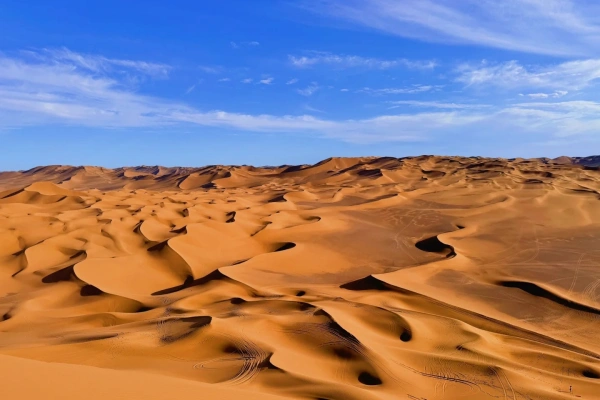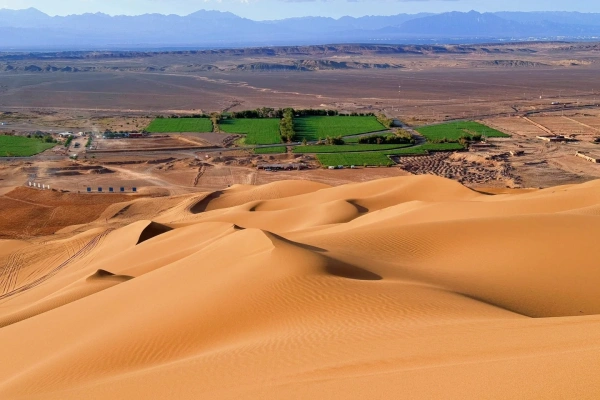Kumtag Desert
Historical Overview
The Kumtag Desert has been a crossroads of civilizations for millennia, its name derived from the Uyghur words “Kum” (sand) and “Tag” (mountain), meaning “Sand Mountain.”
Ancient Silk Road: A vital trade route linking China to Central Asia, the desert’s oases—such as Dunhuang and Turpan—served as rest stops for caravans.
Cultural Influences: The region reflects a fusion of Chinese, Uyghur, and Tibetan cultures, evident in nearby cave temples like the Mogao Grottoes and Bezeklik Thousand Buddha Caves.
20th-Century Exploration: Scientists and adventurers began studying the desert’s ecology and geology in the 1950s, leading to its 2002 designation as a national park.
Modern Conservation: Efforts to combat desertification and protect endangered species like the wild Bactrian camel have intensified since the 2010s, with international partnerships supporting sustainable tourism.
Geographical Features
The Kumtag Desert’s landscape is defined by its dramatic dunes, vast sand seas, and rare desert flora and fauna.Crescent Moon Dunes: Towering up to 300 meters, these iconic dunes near Dunhuang shift daily with the wind, creating a mesmerizing, ever-changing terrain.
Singing Sands: The desert’s southern dunes produce a low, resonant hum when disturbed, a phenomenon caused by friction between sand grains.
Hami Basin: To the east, this arid region features salt flats, dry riverbeds, and rare desert willows, adapted to survive extreme conditions.
Oasis Ecosystems: Scattered oases like Aydingkol Lake (China’s lowest point at -154 meters) support poplar forests, reeds, and migratory birds, offering a stark contrast to the surrounding desert.

Major Attractions
From adrenaline-pumping activities to serene natural vistas, the Kumtag Desert caters to all types of travelers.Dune Surfing & Camel Treks: Slide down steep slopes on sandboards or ride camels across the dunes, following ancient Silk Road trails.
Crescent Lake Oasis: A mirage-like spring surrounded by sand dunes, this UNESCO-listed site has existed for over 2,000 years and is linked to the Mogao Crottoes.
Kumtag Desert Park: A 3,300-square-kilometer protected area with hiking trails, observation towers, and educational exhibits on desert ecology.
Starry Nights: With minimal light pollution, the desert offers unparalleled stargazing opportunities, especially during meteor showers in August and December.
Suggested Itineraries
Half-Day Adventure (4–5 Hours)
Morning: Arrive at Kumtag Desert Park → Camel trek to Crescent Moon Dunes (1 hour) → Dune surfing (1 hour).
Afternoon: Visit Crescent Lake Oasis → Explore the Mogao Grottoes (if time permits).
Highlights: Iconic dunes, cultural heritage, and quick thrills.
Full-Day Exploration (8–10 Hours)
Morning: Sunrise photography at the dunes → Camel trek to remote oases → Picnic lunch.
Afternoon: Guided hike through Hami Basin → Visit Aydingkol Lake → Sandboarding session.
Evening: Sunset dinner at a desert camp → Stargazing.
Highlights: Off-the-beaten-path landscapes and immersive experiences.
Multi-Day Cultural & Nature Tour (3–4 Days)
Day 1: Dunhuang city tour (Mogao Grottoes, Crescent Lake).
Day 2: Kumtag Desert Park activities → Overnight in a yurt camp.
Day 3: Hami Basin exploration → Visit Turpan’s Flaming Mountains and Karez irrigation system.
Day 4: Return to Dunhuang or extend to Urumqi for further desert adventures.
Highlights: Deep dive into Silk Road history and desert ecosystems.

Ticket Purchase
Online: Book via the official Kumtag Desert Park website or travel platforms like Ctrip (up to 3 days in advance).
On-Site: Tickets available at park entrances; lines are shorter in early morning or late afternoon.
Prices:Standard Entry: ¥120–150 (includes park access and basic activities).
Combo Tickets: ¥200–300 (includes camel rides, sandboarding, and guided tours).
Night Tours: ¥80–100 (stargazing and cultural performances).
Free Admission: Children under 1.2m, seniors over 70, and disabled visitors.
Transportation
By Air: Fly to Dunhuang Airport (DNH) from major cities like Beijing, Shanghai, or Urumqi (1–3 hours), then take a 30-minute taxi to the desert.
By Train: High-speed trains connect Dunhuang to Lanzhou (6–8 hours) and Urumqi (10–12 hours); local buses or taxis cover the final leg.
By Bus: Daily long-distance buses run from Turpan, Hami, and Urumqi to Dunhuang (4–8 hours).
By Car: Rent a 4WD vehicle for flexibility; the desert is accessible via the G30 Connecting Highway from Dunhuang.
Best Time & Tips
Avoid Crowds: Peak Season: May–October (especially national holidays). Best Times: April–May (spring wildflowers) or September–October (mild temperatures).
Weather: Summers (Jun–Aug) are scorching (40°C+); winters (Dec–Feb) are freezing (-10°C to 5°C). Spring and autumn offer ideal conditions.
Essentials:Pack sunscreen, wide-brimmed hats, and sunglasses (sand reflects sunlight).
Wear closed-toe shoes with good grip for dune hiking.
Bring a reusable water bottle (dehydration is common).
Respect local customs; dress modestly when visiting nearby villages.
Prohibited Items: Drones (require prior permission), littering, and feeding wildlife.

